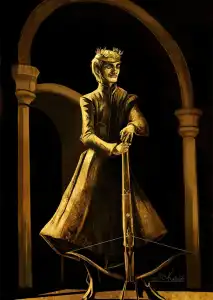Chapter 150 (1) - The Mysterious Art Museum |
In a Dream.
I stood, gazing quietly at the yellow house about 50 meters away from where I had opened my eyes.
The exact time was unknown, but it was very late at night. Lights were on in the house, and a window was open.
Next to the yellow house was a cafe, already closed due to the late hour. There were no people around.
If Van Gogh was still in the yellow house of Arles, he might be painting sunflowers, waiting for a friend, or perhaps already engaged in joyful artistic activities with a friend.
I slowly walked towards the yellow house and headed for the open window.
Then, a loud crashing sound of a breaking bottle reached my ears. Seeing shards of glass flying out of the window, I frowned and quickly peered inside from the window.
Inside the house.
A man with deep double eyelids and strong frown lines sat at the table, supporting his chin with his hand. It was Paul Gauguin. He had finally arrived.
The alcohol that ruined Van Gogh, absinthe.
This liquor, known as the green fairy or the green devil, is light green in color when poured into a transparent glass.
At that time, the bitter wormwood, which is a main ingredient of this liquor, contained thujone, a compound that could affect the nerves, causing hallucinations or, with long-term consumption, potentially destroying the optic nerve. This led to its production being banned for almost 100 years from 1910 to the 2000s.
I watched Van Gogh, who was blankly blowing into a new bottle.
"That poisonous liquor."
Depending on the brand, this liquor usually contains an alcohol content of 45-75%. In its pure form, it can even exceed 80%.
It's typically diluted with ice when consumed, but Van Gogh was drinking this poisonous liquor straight from the bottle.
Van Gogh, gulping down the liquor and roughly wiping his mouth with his sleeve, glares at his friend as if he were an enemy.
"How could you do that!"
Gauguin, looking confused and slightly irritated, says,
"What exactly are you so angry about?"
Van Gogh, pointing at a pair of canvases set aside, shouts,
"How could you paint such pictures!"
I pushed my head through the window to see the paintings Van Gogh was pointing at. As soon as the two paintings came into view, I closed my eyes tightly.
"This very scene."
The reason for their fight.
It was because of two portraits they had painted simultaneously of the same model. Of course, there were other reasons, but the decisive one was the difference in interpretation of the paintings.
The two paintings, known as 'The Woman of Arles.'
These were paintings of Mrs. Ginoux, the owner of the inn where Van Gogh had left his luggage when he first came to Arles, with whom he had become friendly.
Two paintings of the same model.
However, the atmosphere emitted by the woman was completely different in each.
In Van Gogh's painting, Mrs. Ginoux sits at a table in front of a yellow background, reading a book. An excellent painting already establishing the unique atmosphere of Van Gogh's portraits.
The yellow background makes the figure stand out more vividly, giving off a mystical aura. The lady reading a book looks elegant and refined.
What about Gauguin's portrayal?
In his painting, besides Mrs. Ginoux, other people are also visible.
Mrs. Ginoux, with her chin propped up and a strange smile, at the front of the image.
And several other people drinking at another table in the background.
A worldly scene without any sense of elegance or grace.
Van Gogh slams a bottle on the table and yells,
"Didn't you paint the lady in a vulgar manner! She's not that kind of person!"
Gauguin frowns.
"Aren't you a painter? A painter should be able to paint what he sees, but also understand the unseen. Painting the bar woman as noble is because you're grateful to her, right? Why should I follow your lead and paint a vulgar woman nobly?"
"What!!!"
Van Gogh yells as he rips off his shirt buttons.
"Then! The man drinking behind me! Why did you paint this? Isn't this Joseph?"
"Yes, that's right. The postman."
"Joseph is like a benefactor to me! To paint such a person like this, are you in your right mind!"
"I only painted what I saw."
"Painted what you saw! When did Joseph ever sit in a tavern, drinking with prostitutes, making such a vulgar face! He's a man who knows nothing but his wife and children!"
"To me, he seemed that way. His nose was so red from drinking. Seeing such a face, it's natural to imagine such a scene."
"You said you paint what you see!"
"I also paint what I don't see."
"Are you trying to play word games with me now!"
"Ha! I can no longer converse with you. Just yelling foolishly. I'll go back to my painting, drink alone or do whatever you please."
I looked at the two repeating their arguments with a sorrowful face.
Whether Van Gogh drinks more or not, Gauguin picking up his brush. And seeing the painting he was working on, I sighed.
"Please. Don't paint that painting."
Read ahead by supporting me on Ko-fi
.

















